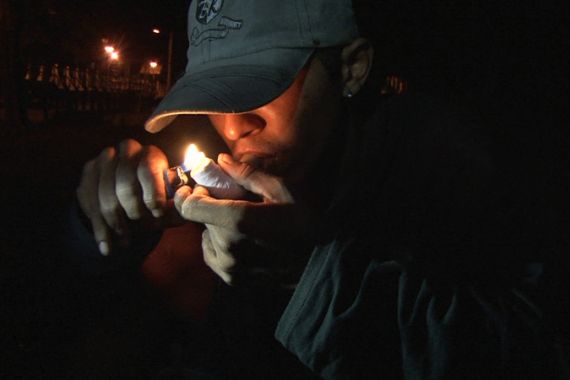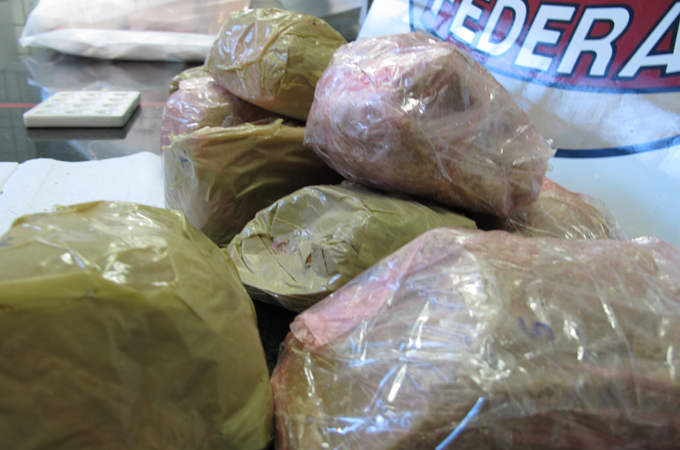Inside Brazil’s toxic drug culture
Twice as powerful as crack cocaine, the new highly-addictive street drug Oxi is causing a public health emergency.

 |
| Cocaine paste, the main ingredient for Oxi, sits wrapped in plastic after it was confiscated by Federal Police in Rio Branco, Brazil [Gabriel Elizondo/Al Jazeera] |
Just after sunset, two skinny young men in their twenties sit in shadowy corner of a park in Rio Branco – located in the state of Acre, Brazil. They have a cigarette lighter, hand made pipes, and a small, yellowish-white coloured rock.
They ask that their full names not be used, and their identities be protected.
One of the young men – using the pseudonym “Joao” – gently places the rock on the aluminum foil that covers one end of the pipe, making sure it doesn’t drop on the grass and get lost in the dark.
Looking at the rock, Joao mumbles: “This is to make my mind go to sleep.”
Then he ignites the lighter, puts the pipe to his lips, and slowly burns the rock whilst inhaling deeply.
He passes the lighter to his friend sitting next to him, who repeats the process himself.
“It’s so good,” Joao says, trying to hold the smoke in his lungs as long as he can. “The pleasure of this drug is at this very moment. When you inhale, it’s the first five seconds that is the ecstasy of this drug, when it comes to your brain. You feel your ear making a buzzing sound. You forget everything. The only thing in my head right now is the sensation of the drug.”
It’s one of the most destructive new drugs hitting Brazil – called “Oxi” on the streets – and has its origins here in the Amazon region. It is cheap, powerful and lethal. So lethal, in fact, that odds are both these two young men, if they continue to smoke it, will be dead within a year.
What is Oxi?
On the surface, Oxi is not a particularly unique drug. It is a derivative of cocaine paste, the clay-like foundation product used to make crack and refined powder cocaine. To make Oxi, chunks of freebase cocaine are soaked in gasoline. When gasoline is not available, kerosene is sometimes used. It is then mixed with limestone powder, a product used in construction. Easily attainable household solvents, like cleaning chemicals, are also sometimes added to the toxic mixture. In the final process, the rocks are dried, often simply under the sun, and then sold on the streets for consumption.
According to police, with cocaine paste as the main ingredient, Oxi can be made very easily and cheaply without the need for a background in chemistry – unlike refined powder cocaine, which needs the infrastructure of a laboratory to produce, and is much more time-consuming and complicated.
“The process [to make Oxi] can be done anywhere, by anyone,” Marcelo Moscardi, head of the Federal Police office in Rio Branco, Brazil, told Al Jazeera. “It’s a very simple process.”
The end result is that Oxi is considered almost twice as powerful as crack or cocaine.
|
A young man in Rio Branco, Brazil holding a rock of Oxi [Gabriel Elizondo/Al Jazeera] |
“The difference between [Oxi] and crack is that crack usually has about 40 or 50 per cent purity, but based on our studies of what we have confiscated, [Oxi] is being made from freebase cocaine that has 80 to 90 per cent purity,” Moscardi said. “That is why everyone says it’s stronger and the effects of addiction faster, and consequently it is considered a better drug by the users.”
Because Oxi is so easy to make, it is cheap – the average price for one rock being five Brazilian reals, which is the equivalent of about three American dollars. Sometimes, a rock of Oxi can sell for as cheap as one American dollar.
The ‘Amazon drug’ that is spreading in Brazil
Officials in the Amazon region of Brazil first started hearing drug users refer to Oxi in about 2005.
Officials say Oxi had probably been used as early as the late 1980s, but was likely mistaken for crack cocaine.
Oxi is often referred to as ‘the Amazon drug’ because it first appeared in the tiny northwestern Brazilian state of Acre. With a population of only 732,000, Acre is just a small sliver of Brazil that borders both Bolivia and Peru – two of the largest producers that import freebase cocaine paste into Brazil.
Last year alone, federal police in Acre confiscated over 500 kilos of base paste cocaine, according to Moscardi. That number has increased every year since 2005, he said. But with thousands of kilometres of porous borders in the thick Amazon forest, analysts say that Brazilian police likely confiscate less than 15 per cent of the total amount of cocaine coming into Brazil.
From Acre, much of that cocaine paste is sent to other parts of Brazil, to be turned into refined powder cocaine in clandestine labs. But increasingly, because it’s so easy to make, it’s also being turned into Oxi.
Because it is cheap, Oxi was initially used primarily by people from lower economic classes. Combined with the fact it first appeared in the Amazon region of Brazil, the drug is often called “an Amazon drug for the poor”.
But that is now changing. Oxi has already gripped most of Brazil’s seven northern states that make up the Amazon region, and in recent months it has been seen in large population centres in the south of Brazil.
Last week more than 1,000 capsules of Oxi were confiscated from a woman in downtown Sao Paulo – the largest Oxi bust ever in that city. In Minas Gerais, also in the southeast of the country, a man was caught with a chunk of Oxi weighing 506 grams – the first time the drug has been seen in that state – which is enough to make over 100 little rocks. And in Rio Grande do Sul, in the far south of Brazil, police last week found someone with 300 grams, also the first time the drug has been seen in that state.
Last week alone officials in four different Brazilian states announced their first apprehensions of Oxi traffickers.
In the past few months, Oxi has also been identified in the capital of Brasilia, as well as the states of Mato Grosso do Sul, Parana and Bahia.
“This can no longer be called only an Amazon drug for the poor,” Alvaro Mendes, a researcher who helped conduct the first study of Oxi back in 2005, told Al Jazeera. “Back in 2005 it was mostly in Acre, but now it’s in all the Amazon region and spreading to the rest of Brazil. It’s also now being used more and more by middle and upper-middle class.”
Federal authorities in Brazil have yet to publicly announce any national policy to combat Oxi, but Mendes thinks that needs to change. “We urgently need a focused, national policy to combat this drug,” he said.
Deadly effects
With Oxi quickly spreading to all parts of Brazil, it has triggered a wave of national media attention in recent days, all with the same basic question: “What is Oxi?” Nowhere can that question be better answered than in Rio Branco, the otherwise quiet and picturesque capital city of Acre, bordering the meandering brown waters of the Acre River. This was the first city to be hit by Oxi back in 2005, and it’s here where the drug has run rampant, causing a public health emergency.
|
Al Jazeera’s Gabriel Elizondo interviews a young man in Rio Branco, Brazil who uses Oxi two to three times a day [Maria Elena Romero/Al Jazeera] |
At almost any hour of the day, men and women hooked on Oxy walk the streets of the central part of the city in a trance-like state, their frail bodies deteriorated by the effects of the drug. They are mostly un-bathed, and many are barefoot, some even wandering aimlessly through traffic.
Oxi ravages internal organs, causes severe weight loss and critical brain damage. But it is highly addicting; most users who try it get hooked in the first try.
The immediate effect after smoking it lasts only three to five minutes, so most users say they are always looking to get their next hit. A user can normally get five inhales on one rock, extending the total buzz from one rock to roughly 20 to 30 minutes, depending on how experienced the user is and how long the smoke is kept in their lungs.
Regardless of the prowess of the user, the effects do not last long, and leave the victim searching for another hit soon after they finish.
Many Oxi users are so desperate for the drug, they consume it for days or weeks at a time in abandoned buildings. One former user in Rio Branco told Al Jazeera that many users forget about basic things – such as personal hygiene – and therefore sleep in their own faeces in drug dens.
Elias, another recovering addict interviewed by Al Jazeera who asked his full name not to be used, said he once sold his kids’ new clothes in order to pay for the drug. “One day my wife said, ‘choose between me and your kids, or Oxi’. I chose Oxi. That shows you how strong that drug is,” he said.
On another night, Al Jazeera met with a current Oxi user in Rio Branco, who also asked his name not to be used. He is 24 years-old, and says he smokes Oxi two or three times a day, seven days a week.
He has a family, he said, but prefers to sleep in abandoned buildings with other Oxi users. He has no identification documents. When he is not using Oxi, he says he spends his time picking through garbage looking for food, or simply wandering the streets looking to buy his next hit.
“It’s a good drug,” he told Al Jazeera. “I use it because it’s like a temptation of the enemy that urges you to use the drug.” He said he uses Oxi because the effects are powerful and it’s cheap. He says he is aware the drug kills quickly, but says he can’t stop.
Mendes, the researcher, said Oxi is the most addictive and powerful drug he has ever seen. “In the 15 years I have been working with chemical dependency, I have never seen a drug with such a potential of destruction as Oxi.”
In his 2005 study, Mendes tracked 80 Oxi users for over a year, and 34 died while the study was still being conducted.
“When a person starts using Oxi, on average they die within one year,” Mendes said.
Back at the dimly lit park, it has been about 25 minutes and “Joao” and his friend have smoked both the rocks they had. The immediate buzz has worn off, but before they leave, Joao has something he wants to say: “I once saw a man force his wife to sell her body as a prostitute just so he could buy Oxi. A person will do anything for this drug. You lose your shame when you take Oxi.”
Joao and his friend then stand up, put their pipes in their pockets, and walk off.
Soon, they’ll likely be looking for their next hit.
As Oxi’s clenched grip on the Amazon tightens, its toxic fingers are starting to creep outward towards new parts of Brazil.
Gabriel Elizondo is an Al Jazeera correspondent based in Sao Paulo, Brazil. Follow him on Twitter @elizondogabriel
This article was reported from Rio Branco, Acre, with assistance from video journalist, Maria Elena Romero.
Al Jazeera will air a two part series on Oxi in Brazil on Tuesday, May 17 and Wednesday, May 18.

